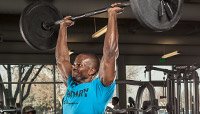One of the most entertaining aspects of having a smart phone in the gym is capturing the goofball who has no idea what he's doing while exercising, and then posting his antics online. The poor guy thinks he's getting in a serious workout, but he's about to become the clown everyone else thinks is so hilarious.
You know what's really scary? That guy—or girl—could be you or me, or any gym greenhorn, adventurous exerciser, or person willing to try something challenging or new. Not everyone is born with an innate sense of how to do exercises properly, and some movements are much more difficult to master than others. It's time to stop judging and start learning.
With that in mind, here are nine exercises or families of movements that nearly everyone has struggled to do correctly. Know them, study them, and practice them, because not only do you want to save yourself from potential injury and wasted effort, you do not want to be the subject of someone else's funny video.
1
Exercise: Biceps Curls
Target Muscle: Biceps
What's Wrong: Straying from Your Sides
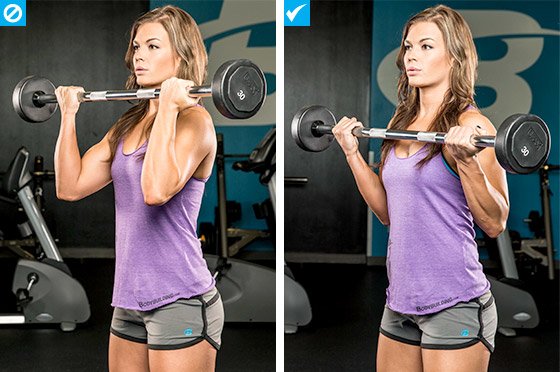
Biceps Curls
This is a common mistake across almost all biceps moves. When you perform a curl, you typically want to raise the weight as high as possible, but doing so often entails pulling your biceps from a fixed position by the sides of your body.
The biceps should be locked by your sides, working as a hinge. When they get pulled forward, the front delts become engaged, which turns a single-joint biceps exercise into a multi-joint shoulders and biceps move.
Furthermore, when you stray from your sides, your hands end up directly over your elbows at the top, which gives you a nice little resting spot and takes tension off the muscle in the peak-contracted position. (That's sarcasm, folks.)
Make This Change: Lock your elbows by your sides for the duration of the set—and keep them there. Whether you're doing standing curls, seated curls, or cable curls, your hands should never be as high as your shoulders in the peak-contracted position, which means your biceps are working hard at the top—not resting.
2
Exercise: Cable Crossover
Target Muscle: Chest
What's Wrong: Pressing Mistakes
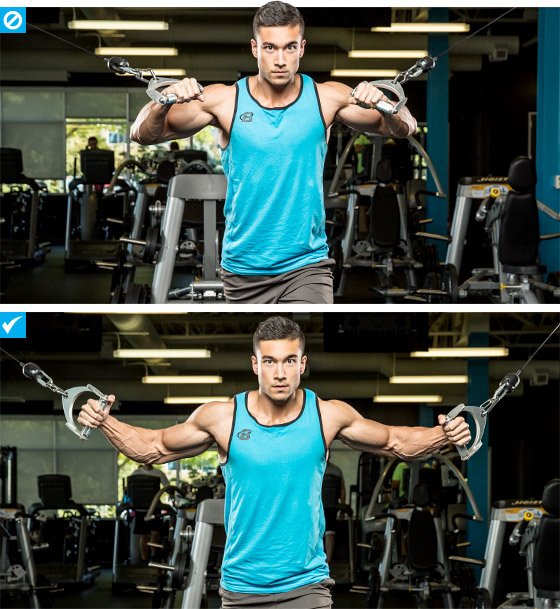
Cable Crossover
This is a single-joint exercise for the pecs, but often it's done like a press. You can tell by watching the elbows: If they close and open up, similar to how you bench press, the triceps are recruited into the movement. That turns this exercise into a multi-joint movement. While that's necessarily not a problem, most people choose cables to isolate the pecs, and if they want to do presses, they can use much more weight with dumbbells or a barbell on a flat bench. So why press with cables?
Make This Change: Lock about a 135-degree bend (halfway between 90 degrees and where your arms are perfectly straight) in your elbows, and hold it there throughout the movement. If you're not sure, watch your form in the mirror; you must maintain that same elbow position from start to finish.
3
Exercise: Dumbbell Kickback
Muscle Group: Triceps
What's Wrong: Dropping 'Bows
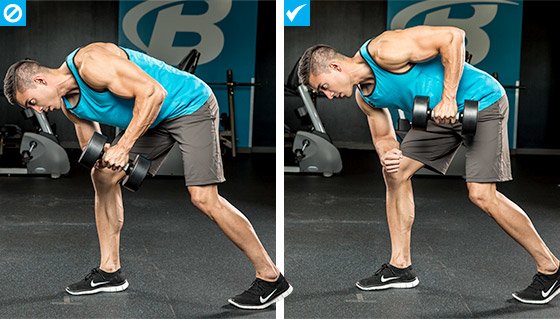
Dumbbell Kickback
If only we had a nickel for everyone who does this wrong! It's common to see someone's working-side elbow drop during execution of this exercise, which means that the triceps get worked through a shorter range of motion. In addition, most people typically pull the weight forward so they're pushing with gravity—not against it—thus generating momentum before the muscle has to do any work.
Make This Change: In the bent-over position, align your elbow beside your torso so that your upper arm is parallel with the floor. It must be locked in this position throughout the set. Use a mirror if you're having trouble seeing this, especially since many lifters inadvertently drop their elbow over the course of the set. Hinge at the elbow, but don't bring your arm down any more than 90 degrees at the bottom of the rep. Your forearm should be pointing directly toward the floor; don't bring it any farther forward.
4
Exercise: Dumbbell Shrug
Muscle Group: Traps
What's Wrong: Rolling The Shoulders
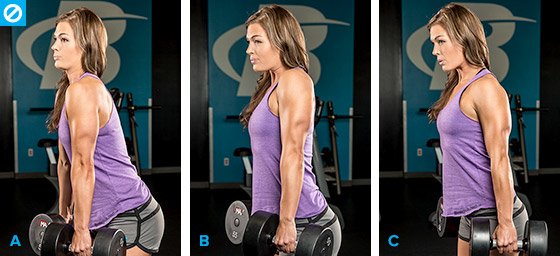
Dumbbell Shrug - Incorrect
If there was any one group of exercises that are done wrong because, well, you saw somebody else doing them this way, it would be shrugs. The villain? Rolling your shoulders in an effort to more thoroughly work the upper traps. This is actually far less effective for building those meaty upper traps, and even puts additional pressure on the discs of your cervical spine.
Make This Change: What's the best way to work your upper traps? Simply elevate your shoulders directly toward your ears in a straight up-and-down plane. A few more important tips: Try not to push your head forward as you shrug, try to keep your arms as straight as possible to keep the focus on the traps, and never, ever, ever, ever look down. (Yes, you'll want to, but don't do it. Heavy weights will take a toll on those discs. If you insist on looking down, the next article we write for you will be on disc herniation.) These tips go for all versions of shrugs, including barbell, dumbbell, and behind-the-back barbell varieties.
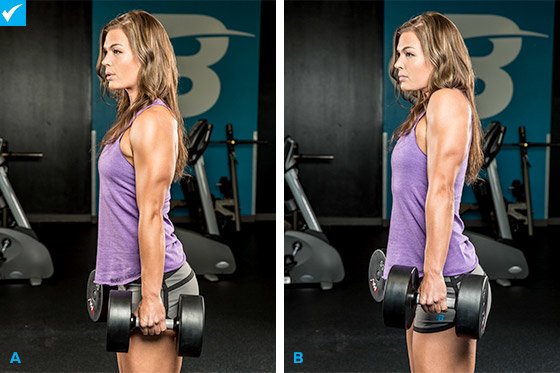
Dumbbell Shrug - Correct
5
Exercise: Leg Press
Muscle Group: Thighs, Glutes
What's Wrong: Sledding Too Low
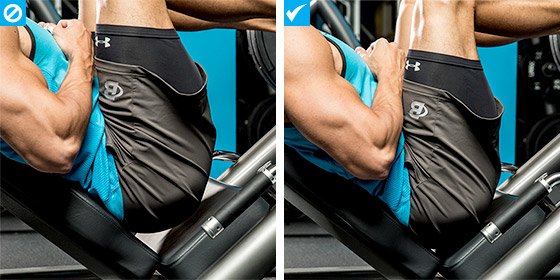
Leg Press
It's hard to mess up a machine move, right? Well, here the problem arises when you lower the sled too far. Because your back is well-supported against the pad, you might not even realize you're making this error. But, as your thighs approach your shoulders, it's easy for your glutes to lift off the back pad, which puts your lumbar spine and discs at a much higher risk for injury.
Make This Change: For one, control the speed of the descent of the leg press to minimize any jolts to your spine. Second, be aware of the point at which your glutes start to lift off the pad; even though you can probably lower the sled even farther, in this case it's not a good idea to increase the range of motion at the expense of your discs. Smoothly reverse direction, pressing through your entire feet.
6
Exercise: Seated Pull-downs and Cable Rows
Muscle Group: Upper lats (when used with a wide grip)
What's Wrong: Swaying To And Fro
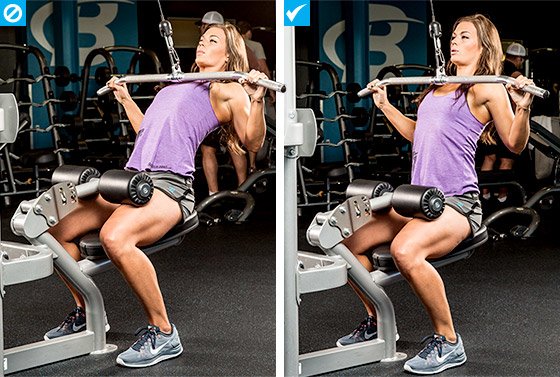
Lat Pulldown
Seesawing forward and backward at the waist as you execute this move turns this upper-lat exercise into one in which the lower back is also engaged, and that's not the intention. Swaying also helps generate momentum, which makes the movement easier.
Make This Change: Strive to maintain an upright position throughout every rep, leaning forward or backward no more than about 10 degrees. This keeps the stress on the upper lats and middle-back muscles.
7
Exercise: Bent-Over Moves
Muscle Group: varies
What's Wrong: Rounding Your Back
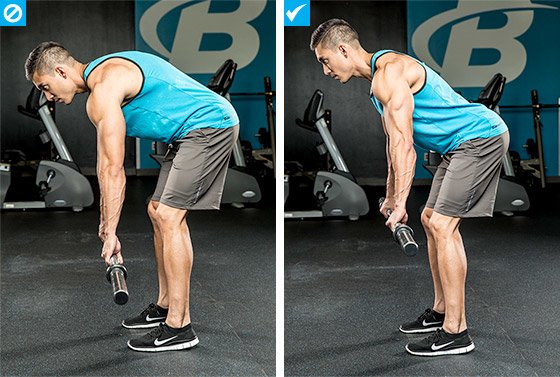
Bent-Over Moves
Getting a hang for this body position is hard if you've never done it right, but once you nail it, you'll never do it wrong again. What we're talking about is maintaining a flat back (even slightly arched) when doing bent-over lateral raises, bent-over rows, and Romanian deadlifts. The overwhelming tendency is to round your back, which puts your discs at risk, especially when you're holding heavy weights.
Make This Change: Turn sideways to the mirror with no weights in your hands and look back at yourself. Bend over about 45 degrees, with a bend in your knees, and hold a slight arch in your back. Press your glutes to the rear and keep your chest up and shoulders back. Keep practicing till you get it exactly as shown. This is the position you need to hold for spinal safety when executing bent-over exercises.
One more thing: When you're facing the mirror in bent-over exercises and looking back at yourself, you've got your neck in a vulnerable position. Here the cervical spine is hyperextended, which is also potentially dangerous to the spine. Keep your neck in the same plane as your body when doing bent-over moves—don't look up.
8
Exercise: Deadlifts
Muscle Group: Back, Traps, Thighs, Glutes
What's Wrong: Mixing Movements
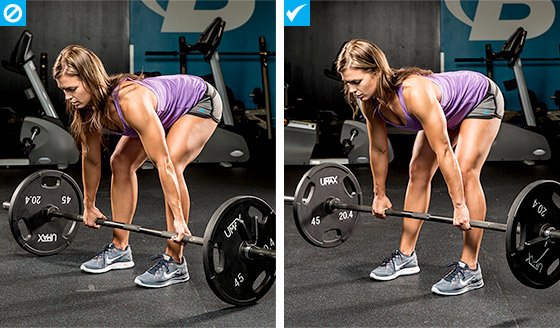
Romanian Deadlift
Maybe it's because the deadlift and Romanian deadlift are both such great exercises and share a common name, but all too often lifters combine elements of each exercise into a hybrid of sorts, causing a unique set of problems. You don't want to simply bend over on deadlifts (which turns this into a single-joint move), nor do you want to have the plates settle on the floor when doing RDLs, which takes tension off the muscle and sends a jolt through your spine.
Make This Change: Understand these are two distinct exercises and learn how to do each properly. The Romanian is best done on hamstrings day (working the glute-ham tie-in exceptionally well), and the bar should never touch the floor from rep to rep. The deadlift requires you to get your butt down at the bottom of the lift, which better engages all the leg muscles. And yes, here the bar should settle on the floor between reps, which gives the deadlift its name, as it comes from a dead stop.
9
Exercise: Internal and External Rotation
Target Muscle: Rotator cuffs, commonly done as a warm-up
What's Wrong: Waving A Dumbbell
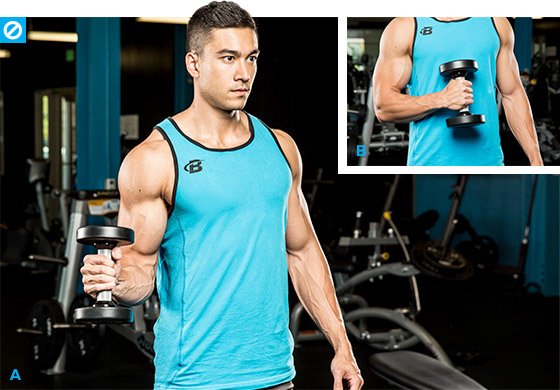
Internal Rotation - Incorrect
You see this one all the time with guys warming up on shoulder day. It's a great idea to warm up your rotators cuffs—a thin group of four strap muscles in the shoulder: the supraspinatus, infraspinatus, teres minor and subscapularis—but standing and waving a dumbbell is a complete miss.
Make This Change: To work your rotators, the line of pull must come from across your body. When you're standing, gravity pulls the weight straight down. So, instead of using a dumbbell, adjust a pulley so that the line of pull is coming across your body at elbow height—keep your elbow bent at 90 degrees during execution—or use elastic tubing tied to a stationary object if the cable weight is too heavy.
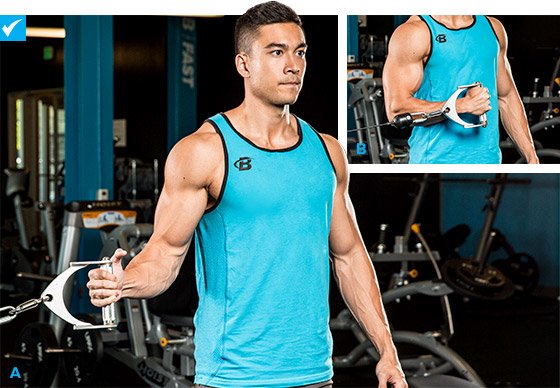
Internal Rotation - Correct
With your elbow tight to your side, acting as a hinge, pull to your outside to work the external rotators, and pull across your body to work the internal rotators. Your internal rotators are probably slightly stronger, so do them after the external rotators. Go for light weight and high reps. By the way, you can work the rotators with a dumbbell, but you need to be lying on a bench, not standing.
Recommended For You

Ab Training: 6 Reasons Your Abs Aren't Showing
Have you been spending hours in the gym working on your abs without seeing results? You may be making one of these errors! Here are 6 reasons your abs aren't showing.
First-Time Fitness: 10 Pro Tips For Beginners
Education is one of the most important tools in a gym-goer's repertoire. Learn a little more about training, nutrition, and supplementation from these 10 pros!